Discover the pros and cons of five intranet publishing models, including how each might fit with your comms team’s content and governance strategies.
Keeping your organization’s employees informed and engaged is an ongoing challenge.
Even with the latest intranet software and all the bells and whistles, generating and managing content that informs and engages effectively can be difficult for your internal comms team. Should you allow anyone in your organization to become a part of your collective of authors or should you keep a tight grip on who has publishing permissions?
When it comes to creating and governing intranet content, having a defined intranet publishing model in place can help to maintain a steady flow of fresh content without placing all the burden on your internal comms team. Yet there are a few different models to consider, each with their own pros and cons.
Before we dive in to those different models, let’s brush up on our collective understanding of what an intranet publishing model is.
What is an intranet publishing model?
An intranet publishing model is a method of creating and distributing content within an organization’s intranet. It often involves creating and managing content centrally, then publishing it to your intended audience. This model is used to ensure consistency and control over the content that is accessed by employees, and to improve communication and collaboration within the organization.
Free guide for multichannel communications
A centralized intranet publishing model can have a few drawbacks, which we will explore below. With potential drawbacks in mind, it is worthwhile understanding alternative publishing models and considering each of them when it comes to creating and managing engaging content on your intranet.
5 intranet publishing models favored by experts
The centralized intranet publishing model
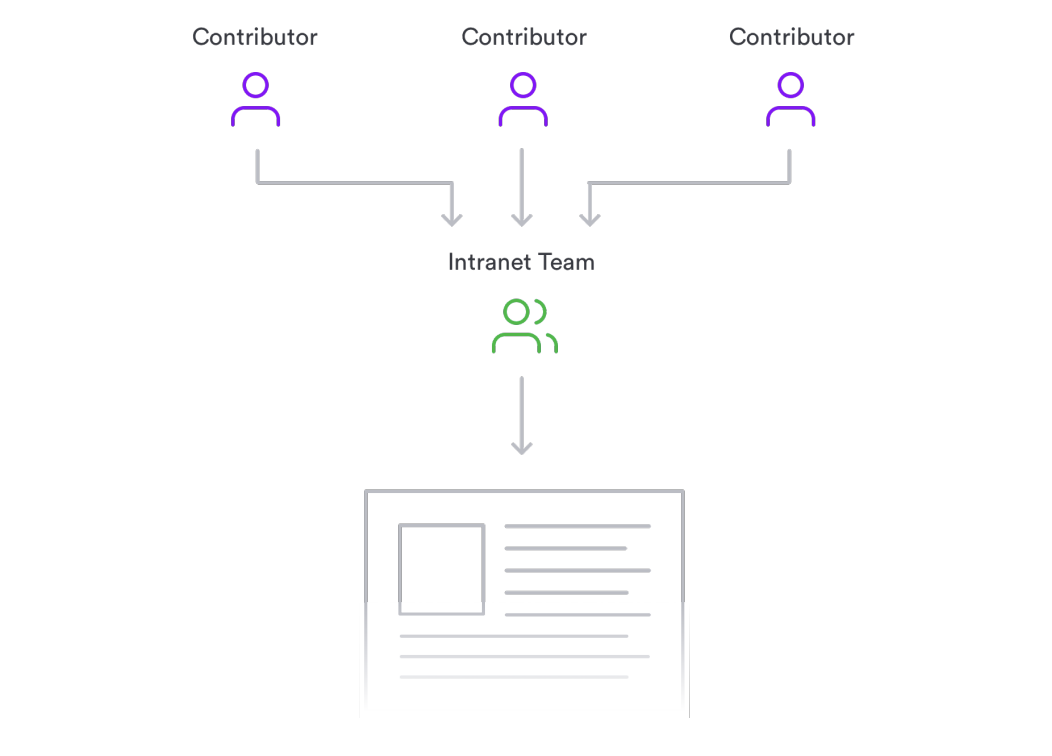
The centralized publishing model is a traditional and straightforward intranet publishing model. This model involves a specific group of individuals – or a department – that creates, approves, and publishes all content for the intranet. This can be ideal for organizations with strict governance policies where a single department or team manages the content that goes out to employees.
One of the primary advantages of the centralized publishing model is that it ensures consistency across all the content published on the intranet. However, it can create bottlenecks as all content must go through the approval process and comms teams who govern this are usually small.
This model puts a lot of pressure on the comms team, and to govern the content effectively they must have a deep understanding of the organizational culture, business values, and brand, and ensure the content meets expectations in each of those areas.
Benefits:
- Ensures consistency
- Ensures quality
- Reduces training requirements, as work is done by a core team
- Provides constantly available resource
Drawbacks:
- Can easily become a bottleneck
- Limits distributed ownership
- Negative impact on engagement as business areas have reduced responsibility and accountability
- Little justification of content submission by business units, meaning content volume could become excessive
Best for:
- Top-level sections of the site
- Key resources
- Supporting business units with insufficient resource
- Supporting business units with infrequent publishing requirements
- ‘Top down’ news articles and company-wide communication or engagement campaigns, to ensure consistency of message and brand
The decentralized intranet publishing model
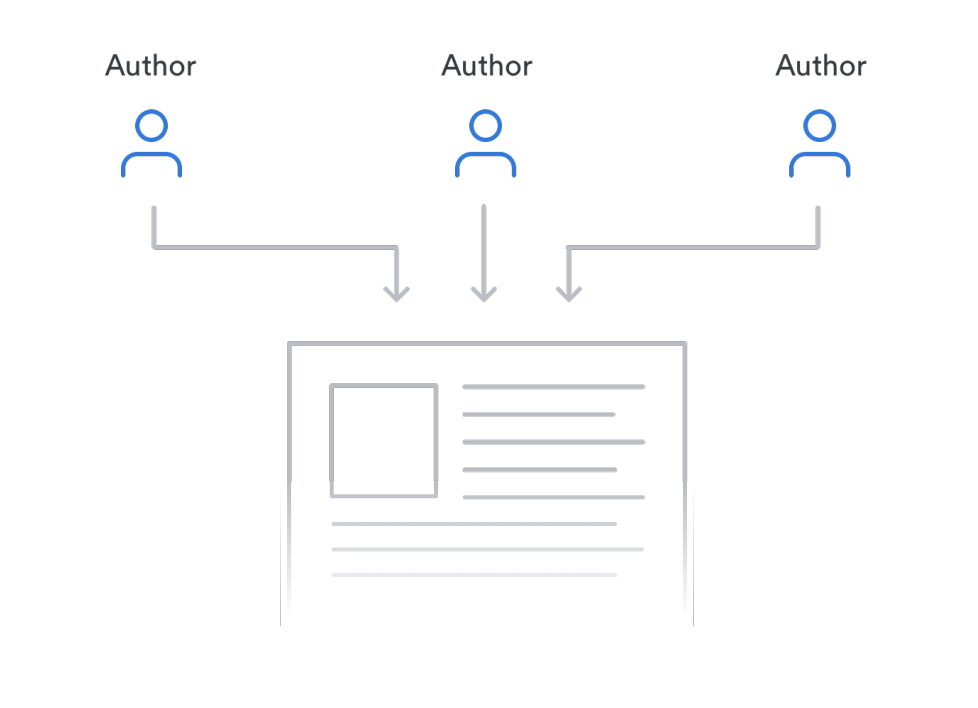
The decentralized publishing model is the opposite of the centralized model. It allows all employees to create and publish their own content on the intranet.
This model is ideal for organizations that want to encourage employee engagement and foster a culture of innovation and collaboration by empowering employees to share knowledge, ideas, and opinions with their peers.
One of the main advantages of this intranet publishing model is that reduces pressure on the publishing team and allows employees to take ownership of how they collaborate and communicate across the intranet and its channels. However, organizations using this model may find it challenging to ensure content quality and accuracy.
To mitigate this risk, clear content creation guidelines should be established and employees should receive adequate training and support.
Benefits:
- Gives responsibility to business units
- Content could be more responsive and timely
- Content creation becomes integrated
- Taps into the experience and knowledge of a wider pool of authors
Drawbacks:
- Quality could be inconsistent, regardless of formal training
- User experience may be affected
- Increases burden on central team to provide support
- Could become chaotic unless effectively managed
- Central team can often default into content management role due to a lack of input on authors’ part
Best for:
- Large, mature intranets
- Large/enterprise-level organizations
- Social-savvy organizations
Publishing with review
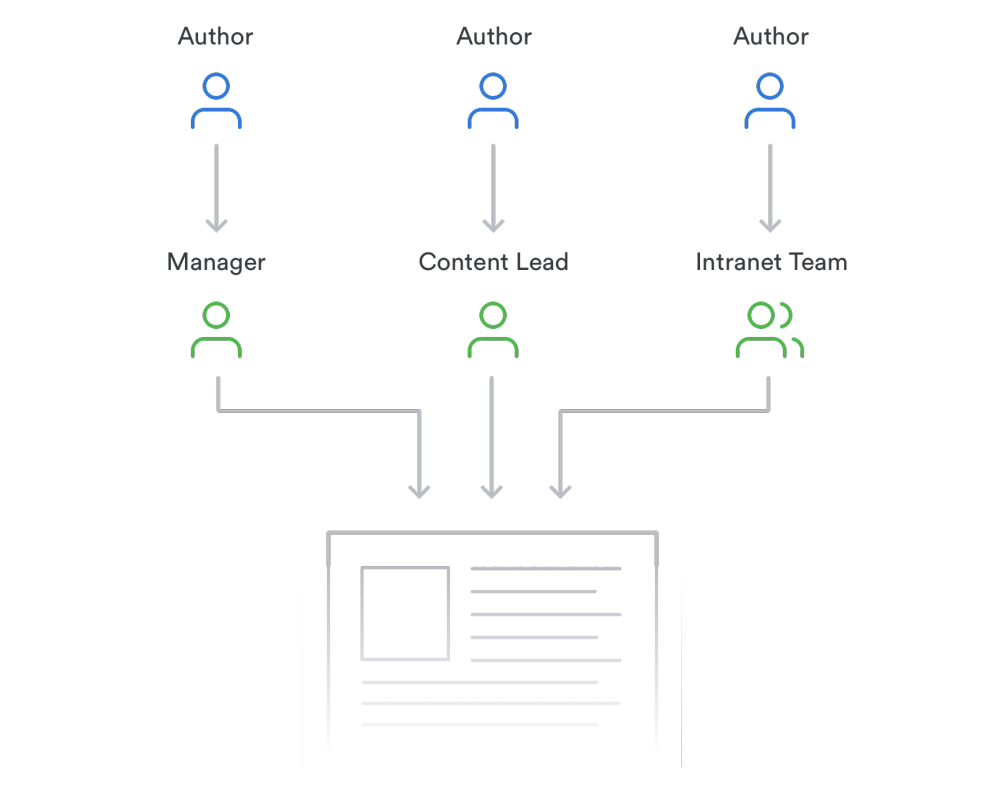
The publishing with review model combines aspects of both the centralized and decentralized models. It involves a small group of individuals who manage and approve content for the intranet, but also allows employees to create and publish their own content. This model is ideal for organizations that want to strike a balance between consistency and innovation.
One of the main advantages of the publishing with review model is that it allows organizations to maintain consistency in their brand messaging and compliance policies while also promoting employee engagement and creativity. However, it requires a robust governance structure and clear guidelines for content creation and approval.
Benefits:
- Content is double-checked
- Improved quality and consistency
- Reduction in errors as a second set of eyes proofreads
- Improved accountability
- Allows for tracking of changes
Drawbacks:
- Additional step means additional time and effort
- Slow speed of publication
- Bottlenecks can occur
- Different reviewers may have different focuses; for example, checking for consistency, not accuracy
Best for:
- Sections where quality and accuracy are mandatory requirements, such as key business policies
- New content authors
End-user content contribution
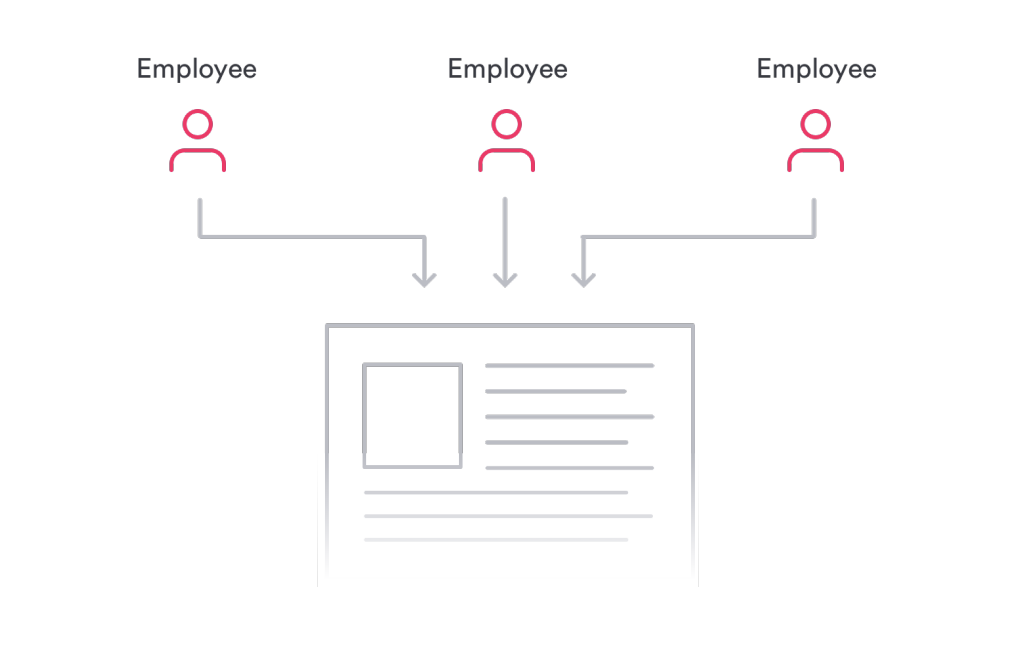
The end-user publishing model is similar to the decentralized model, but it includes a robust governance structure. In this intranet publishing model, all employees can create and publish content, but there is a dedicated team in place to vet the content before it is published.
This model empowers employees to create and share content that they feel will be meaningful to their co-workers while also ensuring quality control. While this is a key advantage, reviewing each piece of content can be laborious and time-consuming for the team that vets it before it gets published.
Benefits:
- Increases engagement
- Allows instant publications and the ability to be more responsive
- Addresses less formal content needs
- Simple method
- Allows for organic growth
Drawbacks:
- Potential quality issues
- User-generated content needs to be differentiated from more formal content
- Less structured and consistent
- Risky
Best for:
- Informal content such as blogs, forums, timeline posts
The federated publishing model
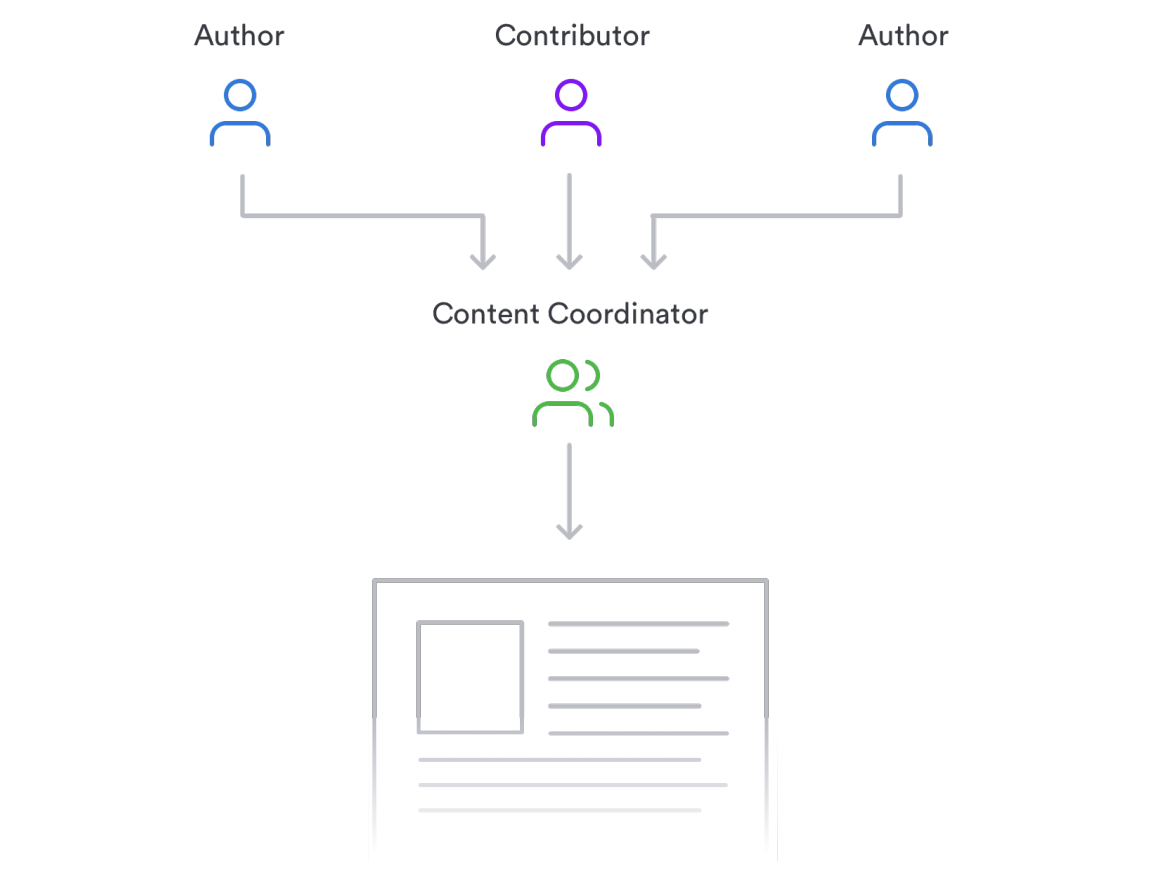
The federated publishing model is ideal for organizations with multiple locations or business units. This model allows each location or business unit to create and manage its intranet while maintaining a consistent look and feel across the organization. Each location or business unit has its intranet team that manages and approves content for its specific intranet.
One of the primary advantages of the federated publishing model is that it provides each location or business unit to promote its subject matter expertise. This model also reduces the number of key contacts for the central team that manages the intranet and reduces their publication workload.
Benefits:
- Scales well
- Hybrid approach
- Brings subject matter expertise to the fore
- Reduces the number of key contacts for central team
- Reduces publication workload on the central team
Drawbacks:
- Business units have to find resource
- Coordinators will need training to ensure consistency across the intranet
- Requires strong management
- Could reinforce ‘silos’
Best for:
- Ensuring a good mix of quality and autonomy
Essential intranet publishing tools
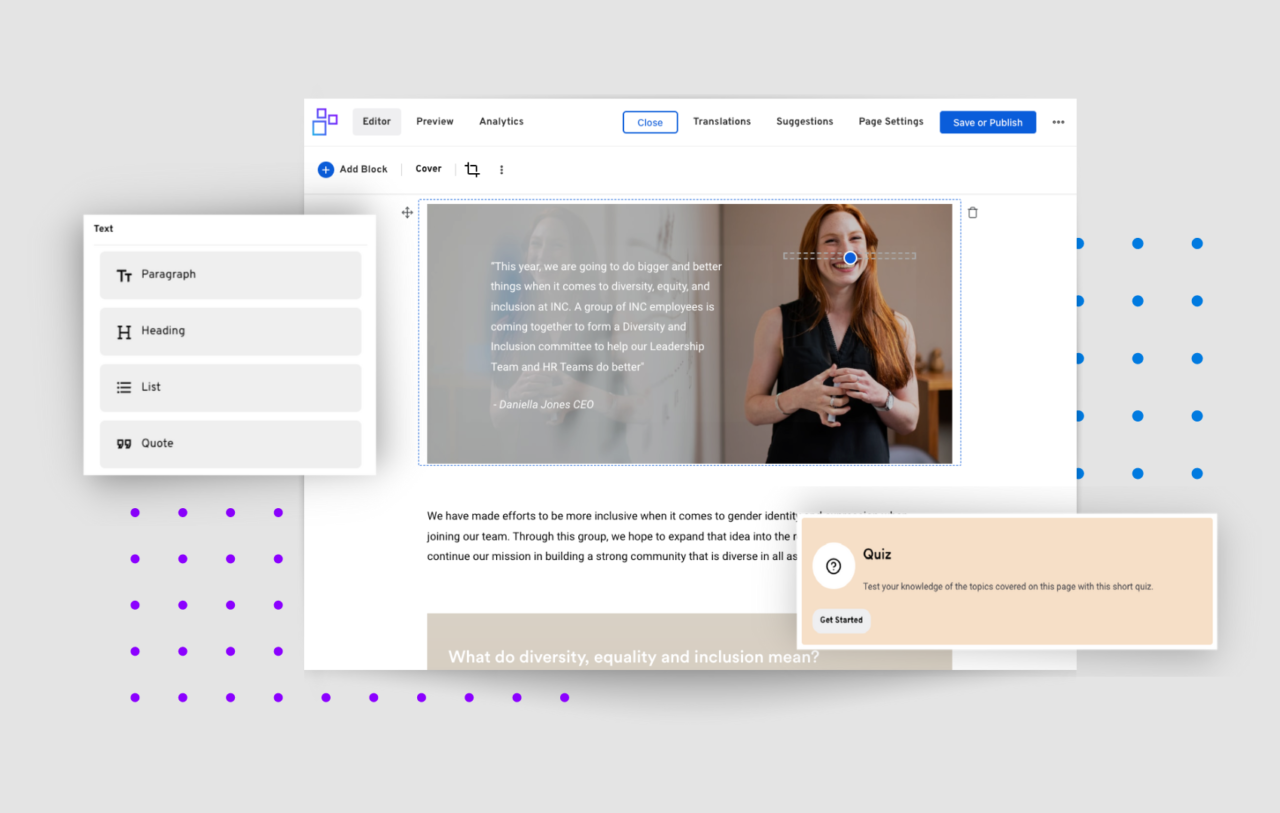
Whether you choose an intranet publishing model that empowers every employee to become an author or you opt for a more structured approach, you need the right publishing tools to help your authors create professional, compelling content.
So what are the top publishing tools you should look for in an intranet? Here are our recommendations:
CMS editor
One way to truly empower your authors is through an intranet that has its own CMS (Content Management System) editor. Interact’s CMS intranet provides users with a drag-and-drop block editor that allows authors to create engaging layouts with various rich media elements, including images, videos, rich links, attachments, and embedded content.
To help aid the creation of content that looks great on every channel, consider an editor that provides WYSIWYG (what you see is what you get) previews of how the content will display while it’s being created.
Inclusivity analysis
Your chosen authors may be great at writing for specific audiences, but when you’re communicating with an entire organization, it’s imperative that the content reads in an inclusive way. A modern intranet CMS should include inclusivity analysis that ensures content is as inclusive as it can be before it is published.
Interact’s own inclusivity checker uses an AI-enabled intranet tool to provide suggestions of more inclusive language and phrases for authors as they type.
Language translation
So you’ve got a great piece of content to share but you need to translate it before you distribute it to internal audiences in different regions. Manual language translation is a lengthy process, and even more so when you need to publish in multiple languages. This is where automatic language translation can make a huge impact, and this is a feature modern intranets are beginning to offer.
Interact’s own language conversation tool uses machine translation to convert text into over 100 different languages.
Real-time monitoring
Any author should want to be able to hone their ability to communicate effectively through the content they produce. Real-time monitoring can help your internal authors do exactly that, providing insights on each piece of content that help authors to improve their content.
Interact’s built-in real-time content monitoring provides detailed performance insights including page visits, channel effectiveness, and social engagement.
Snippet builder
While a drag-and-drop block editor can unlock each author’s ability to structure content in engaging and visually appealing ways, it can become a repetitive task unless the fragments they create with those blocks can be saved and re-used in future internal communications content.
Interact’s block editor allows users to build reusable content fragments, boosting efficiency and creativity by removing the need to repeatedly re-build fragments that have worked well in the past.
Content templates
A worthy CMS editor will also provide pre-built templates for different pieces of content such as blog posts and company updates. This is a great way to standardize content, and Interact’s CMS editor not only features existing templates that can be customized, it also allows users or build and save additional templates.
Auto summary
So you’ve spent a chunk of time authoring a piece of content and editing it in your intranet’s CMS to make sure it’s just right. Just when you think you’re creatively spent, you realize you need to create a summary to help your audience understand what the content is about and encourage them to click through and read it. This is where an automated summary population can step in, helping you to get the content that you’ve been laboring over published and drive healthy engagement.
Interact’s AI-automated summary population tool scans through the content you’ve written and creates a summary that accurately encapsulates what it is about. Not only does this help to get your content over the line, it also helps to improve findability.
Conclusion

Understanding which is the right intranet publishing model for your organization can very much depend on your culture, values, and goals.
For example, while the centralized publishing model is ideal for organizations with strict compliance policies, the decentralized model is ideal for those that want to promote innovation and employee engagement. The other models can offer a balance between the two, but can also require a robust governance structure and clear guidelines for content creation and approval.
Whichever model you choose, it’s essential to provide employees with the tools, training, and support they need to create and publish quality content, and this means investing in the right intranet software packed with intuitive user features. In doing so, you can cultivate a vibrant and engaging digital home for your organization that promotes collaboration, knowledge sharing, and teamwork through fresh and relevant content that piques employees’ interests and meets their needs.
|
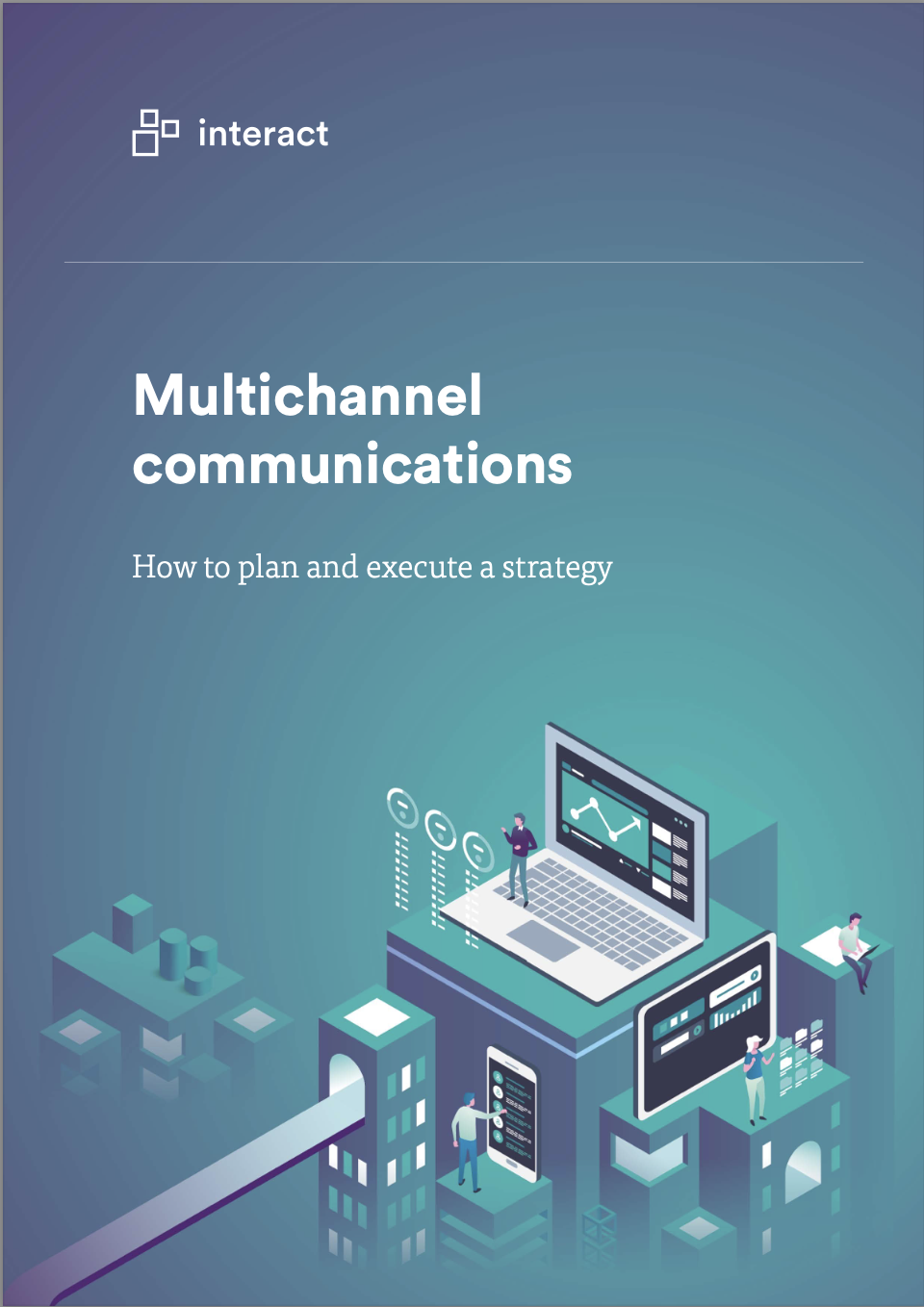


.png)
